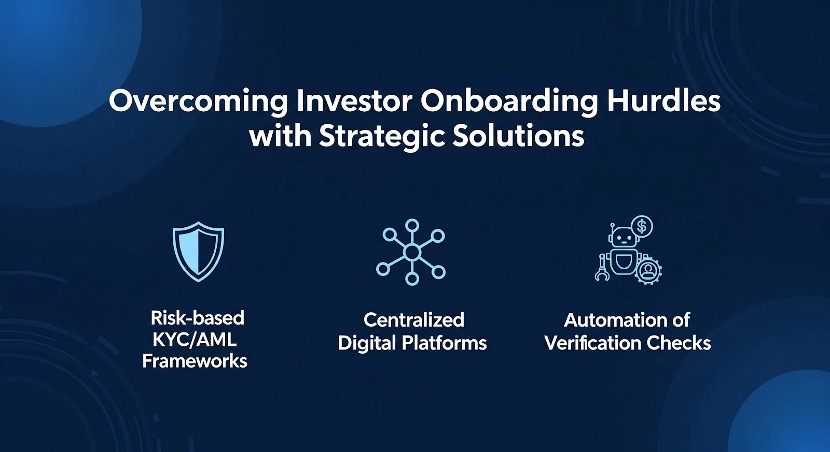Modern Investor Onboarding: Why Does It Matter Now?
Last Revised: September 8, 2025At a Glance
Investor onboarding in private markets is becoming a critical compliance and relationship milestone. Modernizing this process with automation and risk-based checks helps GPs reduce delays, meet regulatory expectations, and deliver a smoother experience for LPs.
In private markets, first impressions matter. For fund managers, the investor onboarding process is not simply paperwork — it is the first operational and compliance test that an LP encounters. A smooth experience builds confidence and sets the foundation for a long-term partnership. A slow, manual process creates friction, delays closings, and risks frustrating investors at a critical moment.
So, why is modernizing onboarding more important today than ever before?

Modern Investor Onboarding: Why Does It Matter Now?
The Shift From Paperwork to Partnership
For years, private market onboarding has been plagued by paper-heavy subscription documents, tax forms, and wet signatures. Firms often spent weeks chasing documents and clarifications, leading to missed deadlines and strained investor relationships.
Today’s LPs — from family offices to sovereign wealth funds — expect the same digital ease they see in other aspects of their financial lives. Uploading documents securely through a portal, tracking status updates in real time, and minimizing duplicative data entry all project professionalism and efficiency.
The difference is not cosmetic: a streamlined onboarding process signals to investors that the GP is organized, technologically capable, and serious about operational excellence.
Compliance and Security in the Digital Age
Regulators globally are raising expectations around KYC, AML, and beneficial ownership transparency. Enforcement actions in both the UK and US highlight the risks of inadequate AML controls and weak onboarding oversight.
Traditionally, investor verification could take weeks — particularly when dealing with layered offshore structures or cross-border investors. Today, automation can dramatically shorten that cycle. Smart verification systems can:
- Validate IDs and corporate records against trusted databases
- Flag higher-risk investors for enhanced due diligence
- Standardize audit trails for regulator reviews
While full onboarding can still take time due to legal and tax complexities, automation transforms the experience from a bottleneck into a managed process, reducing fraud risk and ensuring compliance with global standards.

Automation transforms the investor onboarding experience from a burden into a competitive advantage
The Competitive Edge of a Streamlined Experience
A fund’s ability to onboard investors efficiently can directly influence whether allocations are finalized in time for closing. Delays create reputational risk and may discourage LPs from committing to future funds.
Modern onboarding platforms free staff from chasing signatures and re-keying data, allowing them to focus on what matters most: building and maintaining long-term LP relationships. In a fundraising environment where investor confidence is paramount, operational efficiency becomes a real competitive edge.
Breaking Through Investor Onboarding Bottlenecks
Even the most established GPs face challenges when onboarding LPs. The process is inherently complex, spanning compliance, legal, operations, and investor relations teams. Recognizing common pain points is the first step to addressing them.
Common Onboarding Challenges
Despite best efforts, most firms encounter recurring obstacles during onboarding. These challenges stem from fragmented processes, inconsistent information requests, and the inherent complexity of private market structures. The most frequent pain points include:
- Slow document collection: Investors are often asked for the same information multiple times.
- Beneficial ownership tracing: Multi-layered structures in Cayman, Luxembourg, or Delaware slow verification.
- Jurisdictional conflicts: Different regulatory expectations (SEC, FCA, ESMA, MAS) create complexity.
- Manual exception handling: Email, spreadsheets, and PDF signatures remain the default for many firms.
For high-value institutional investors, these frictions can send the wrong signal at a critical moment. Onboarding is the investor’s first operational interaction with a GP, and repeated requests or delays can damage confidence, raise questions about internal controls, and potentially jeopardize allocations for a closing.
Overcoming Hurdles with Strategic Solutions
Improving onboarding requires balancing compliance rigor with investor experience. Effective strategies include:
- Risk-based KYC/AML frameworks that apply enhanced due diligence only where necessary
- Centralized digital platforms to eliminate duplicate requests and consolidate audit trails
- Automation of verification checks to shorten turnaround times without adding headcount
By embedding these capabilities, firms reduce operational risk while projecting efficiency and professionalism to their investors.

Overcoming Investor Onboarding Hurdles with Strategic Solutions
Tailoring Solutions for Different Investor Segments
Not all investors are alike. A retail-style process may work for smaller individual commitments in feeder funds, but institutional LPs — such as pension plans and insurance companies — require tailored workflows, including specialized tax forms, regulatory disclosures, and custom reporting.
A flexible onboarding platform accommodates both:
- Streamlined, fully digital journeys for standard investors
- Customizable workflows for large institutions with complex requirements
This tailored approach ensures every LP experiences a professional, efficient, and compliant onboarding process, regardless of complexity.
The Bottom Line: Build Investor Confidence from Day One
Onboarding is no longer just an administrative function. Today, it is a critical touchpoint that shapes investor perception and determines how efficiently capital can be deployed.
By modernizing onboarding with automation and risk-based compliance, private market firms can reduce friction, meet regulatory expectations, and strengthen long-term LP relationships. For investors, this means trust and transparency. For GPs, it means faster closings, lower operational risk, and a reputation for excellence.
Why Blackbird?
Blackbird streamlines one of the most complex parts of fundraising — investor onboarding. Our AI-first platform unifies KYC, AML, and due diligence into one seamless workflow, helping private market firms onboard LPs faster, reduce compliance friction, and stay audit-ready, without adding headcount.
Want to see it in action? Book a demo with our team.
For more insights (and the occasional KYC meme), follow us on LinkedIn.
About the Author
Linoy Doron is a Content Strategist at Blackbird, where she translates complex fintech and compliance topics into clear, actionable insights. With a strong background in technology, SaaS, and UX, she crafts narratives that connect product value to the real needs of asset managers in the private market.